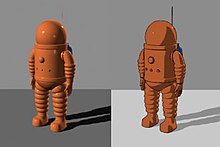Cel shading
Cel shading or cel-shaded animation (sometimes toon shading ) is a technique for non-photorealistic rendering of 3D computer graphics . Images or animations based on a digital 3D model appear as if they had been created by hand in the style of a comic or cartoon . The technology is a comparatively new development in the field of computer graphics (since 1997 in film, since 2000 in games), which is used in the production of cartoons and in computer games . The English term cel comes from celluloid (German: celluloid ), while toon is derived from the English-language cartoon . Both are made up words.
Although the result of cel shading looks quite simple, the process of developing it is complex.
process
The process of cel shading starts with a typical 3D model. It differs from traditional rendering methods in the way these models are displayed on the screen. Instead of letting the shades run smoothly on the object, only three or four levels of brightness are used (usually white, light gray and dark gray, but not black) and textures are almost always dispensed with on surfaces and only individual color tones are used instead. For efficient implementation, the gray levels are stored in a 1D texture and then the required gray value is calculated using the angle between the normal vector of the polygon and the vector from the polygon to the light source. The cosine of this angle is then the desired point on the texture (1 = light, 0 = dark, with values <0 the texture is illuminated from behind and the value is set to 0). The cosine of the angle can be calculated directly from the scalar product of the two vectors. With more modern graphics cards, these calculations can also be carried out directly in the shaders .
In order to display black lines or to draw the contours of an object, backface culling is inverted in order to display triangles in black, which are actually visible in perspective to the rear. These lines need to be drawn several times with slight variations in the inversion to create thick strokes. The back face culling is then returned to normal to show the hues and additional textures for the object. Finally, the overall image is put together using a Z-buffer . The result is an object that is displayed with a black border and even outlines within the object surface.
Use in movies
In comparison to hand-drawn cartoons, films and animations with cel shading enable much more complex effects such as camera pans or a large number of moving objects, as these (relatively inexpensive) have to be designed and calculated and not (laboriously) drawn by hand. This is noticeable, for example, with moving backgrounds, such as B. at the start of the spaceship in Futurama . Here, the movement of the background looks much more realistic than, for example, with the Simpsons , where the camera pans usually only consist of a background moving from right to left and an object in the foreground remains in more or less the same place. Nevertheless, Cel Shading often seems a bit sterile, which is why series like the Simpsons are still drawn by hand.
In principle, cel shading is used in all animation productions that use 3D models and have the aesthetics of a classic cartoon. A selection:
- Animatrix (short films 2003)
- Appleseed ( Anime 2004)
- Futurama (series 1999-2013)
- The giant from space (1999 film)
- The Simpsons: The Movie (2007 film, including some episodes of the series)
- Spirit - Der Wilde Mustang (2002 film, hand-drawn characters, landscapes via Cel Shading)
The films Waking Life and A Scanner Darkly were first shot on film and then digitized with the Rotoshop program by Bob Sabiston and alienated by rotoscopy . This makes these films appear as if they were generated with cel shading.
Use in computer games
In computer games it is an artistic question whether cel shading is used in the graphics engine. When the technology was new there was a whole wave of games (fad). Cel shading is now only used in a targeted manner. There are early demo videos for Studioskami from Clover Studios that show game scenes in the aesthetic of Japanese painting. This was too computationally consuming for the PS2. In the game that was finally released, the cel-shading graphics are much more conventional.
Some popular computer games that use cel shading:
- Afro Samurai (2009)
- Borderlands series (from 2009)
- Breath of Fire: Dragon Quarter (2002)
- Crackdown (2007) - open world action game
- Dark Chronicle (2002)
- Dragon Quest: The Voyage of the Cursed King (2004)
- Eternal Sonata (2007)
- Fear Effect (2000)
- Grand Theft Auto: Chinatown Wars (2009)
- Jet set radio series (2000)
- killer7 (2005)
- Killer Is Dead (2013)
- League of Legends (2009)
- No More Heroes (2008)
- Ōkami (2006)
- Prince of Persia (2008)
- Sly Racoon Series (2003)
- Sonic Shuffle (2000)
- Tales of Symphonia (2003)
- The Walking Dead (2012)
- The Wolf Among Us (2013)
- Viewtiful Joe Series (2003)
- Valkyria Chronicles (2008)
- Warsow (2005)
- XIII (2003)
- X Rebirth (2013)
- The Legend of Zelda: The Wind Waker (2003)
- The Legend of Zelda: The Wind Waker HD (2013)
- The Legend of Zelda: Breath of the Wild (2017)
Web links
Individual evidence
- ↑ Cf. Cellshader.com FAQ , Jennifer Hachigian 2005.
